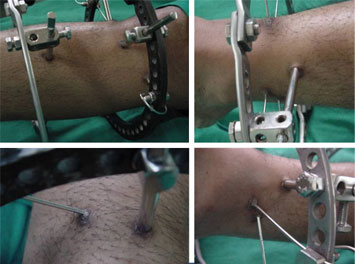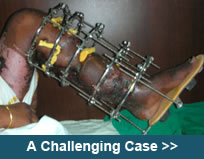| Q. |
What is an external fixator? |
 |
| A. |
External Fixator is a device that is applied to the bone from outside for various purposes, depending on the underlying problem. It is of various types, which again depends on various factors like the underlying pathology, age, type of bone etc. |
|
| |
|
|
| Q. |
How is that applied from outside? |
|
| A. |
The device is held to the bone either by wires or by long screws which have threads only on one end. These are also called pins |
|
| |
|
|
| Q. |
Do I need to take any special care of this while it is applied to me? |
|
| A. |
Not really. You just have to take care of the pins. |
|
| |
|
|
| Q. |
What do you mean by taking care of the pins? |
|
| A. |
Pin care site means the daily cleaning of the pin and skin around the pins. |
|
| |
|
|
| Q. |
That sounds difficult. Will I be able to do it myself? |
|
| A. |
Not difficult at all, all our patients do that on their own without any assistance and help from anybody else; you will know how to do it on your own when we show it to you once or twice.
All you have to do is boil about 1 liter of water for half an hour (half an hour is counted once the water starts to boil and not from the time it is kept on the stove/gas/electric heater). Also boil a small steel bowl along with this. Once that is done let it cool down.
Now when you are ready for the dressing wash your hands and wrist thoroughly using tap water and soap. Use a clean, fresh towel to dry your hands.
The next step is to remove the dressings tied around the pins.
Once that is done, take some of the previously boiled and cooled water in the steel bowl (also previously boiled and cooled). Take a sterile gauze piece (this is the only dressing material which needs to be bought from the chemist), and dip it in boiled and cooled water. Use the wet gauze piece to clean the pin and the skin around it. Hold the gauze piece from its two ends and move it to and fro like we shine the shoes. Clean all sides thoroughly and discard the gauze piece. Take new gauze for every pin and clean them all.
After cleaning them all just tie a dry gauze piece around the pins. You can use one gauze piece to tie around nearby two or three pins. This prevents any fluid that comes out to stain your clothes.
In the initial 5 – 7 days, you may soak the gauze piece in betadine solution, but usually after that, dry gauze piece suffices. |
|
| |
|
 |
| Q. |
Why is daily Pin care site required? |
|
| A. |
The daily Pin care site is very important to prevent any infection around the pins. We need to keep the skin and the pin junction (the point where the pin enters the skin), clean and free of scabs.
It is the normal human body response to form blood clots, and scabs, to heal a wound. With fixators, we don’t want scabs to occur around the pin, because they prevent the normal fluid from coming out, and this fluid can serve as a breeding medium for the bacteria which would in turn increase the chances of infection.
Therefore “Clear fluid coming out is Good, and not a sign of a problem”. |
|
| |
|
|
| Q. |
If this is so important then why can’t the local doctor or nurse do it? |
|
| A. |
Let me give you an example, just because somebody else can brush the teeth better would you go there every morning to get your teeth brushed. I would not. I would rather get my mistakes pointed out and correct them. And this is no rocket science, first we show you the whole process make sure that you have understood it properly, answer all your queries, then we supervise you doing it and correct any mistakes you make, and once you are doing it well we let you do it on your own. |
|
| |
|
|
| Q. |
Doing it on your own has many advantages: |
|
| A. |
- The Doctor and nursing staff are devoted to their patients. They would be able to do the dressings too but the amount of time a patient or relative can devote, that much time a doctor or nurse may not be able to always because they will be rushing to the operation theatre, seeing another patient, attending ward calls etc. You on the other hand know the importance of taking care and also can afford to spend as much time as you want for the cleaning. You can spend 5 min., 10 min., or even half an hour cleaning one pin but the doctor or the nursing staff will not be able to.
We know from the past experience that the patients are able to follow the instructions exactly in the manner we teach them to, and in case of any doubt or clarifications they get back to us.
- This keeps the patient involved with the treatment process, and creates awareness about the fixator and the limb on day-to-day basis. This in turn increases the compliance with the fixator and the exercise program.
|
|
| |
|
|
| Q. |
Then who does it! |
|
| A. |
We usually encourage the patient to do it, but a close relative can also learn the procedure and do it only if the patient is too young to learn, or the pins are difficult to reach. |
|
| |
|
 |
| Q. |
Is the whole process Painful? |
|
| A. |
The daily Pin care site is not painful at all. In the first few days there may be mild pain around the pins, which is a natural response of the body after surgery, but that settles down with medication. |
|
| |
|
|
| Q. |
Is there anything I could do to ease the pain? |
|
| A. |
Yes, while doing the pin site dressing touching and stroking the skin around the pins reduces the sensitivity and helps to ease out the pain. Besides this the regular exercises will keep the pain to a minimum. |
|
| |
|
|
| Q. |
What are the signs I should look out for? |
|
| A. |
- Redness and swelling around a pin.
- Pain in a previously painless pin, or excessive pain in or around a pin.
- Thick yellowish, (ghee-like) fluid/discharge from a pin site.
- Fever.
|
|
| |
|
|
| Q. |
Sometimes I find blood on the dressing. Should I worry about that? |
|
| A. |
When we clean the scabs from the pin sites, there may be a little oozing of blood. A drop or two is not a cause of worry rather it’s a normal thing. Similarly while exercising or during movements the skin around the pins moves and a little blood may come out sticking to the dressing, you need not worry about that.
If the blood doesn’t stop, or the dressing is getting soaked with blood again and again then contact the doctor. |
|
| |
|
|
| Q. |
When can I take bath? |
|
| A. |
Before the sutures (stitches) are removed bath can be taken by covering the operated limb in a plastic to avoid getting the dressings wet.
Once the sutures are removed, usually at the end of 2 weeks from surgery, you are allowed to take bath with the fixator. Keep a separate clean towel for the operated limb and another towel for the rest of the body. Use soap and water to clean the fixator and the limb just as rest of the body. Wipe the limb with the fresh towel. If you have blow dryer (hair dryer) then blow dry the water on the fixator keeping it on cold setting, otherwise the towel will also suffice. Now you can proceed with the routine method of daily Pin care site.
In fact we encourage you to take a regular daily bath with the fixator because that washes away any dust etc. that sets on the fixator and improves the “fixator hygiene.” |
|
| |
|
|
| Q. |
Some of the pins have more fluid coming out than the others, why is it so? |
 |
| A. |
As long as the fluid coming out is transparent, thin and watery, there is no reason for any alarm bells. Some of the pins do have more discharge than others, especially the ones near a joint because of more movement of the skin over the pins nearing joints like knee, ankle, and hip. This does not mean that your movements and exercises are causing any harm; at the most you may have to change the dressing once or twice depending on the amount of discharge. |
|
| |
|
|
| Q. |
Tips for pin site care: |
|
| A. |

|
|
| |
|
|
| |
- The care taken during pin insertion is the key stone for a proper pin site care. If the surgical technique is at fault then the pins are bound to give trouble.
- Daily pin site cleaning using sterile gauze pieces and pre-boiled & cooled water, by the patient or close relative is encouraged. This helps in better care & involvement of the patient in the treatment process, otherwise they tend to “alienate” from the treatment.
- Removal of scabs as shown in the pictures is all that is required.
- Daily bathing with the fixator once sutures are removed not only helps in overall hygiene, it also
helps in pin site care and cleaning of the fixator.
- Despite all the care some of the pins do get superficial infection; oral antibiotics for 7 days and a
caring attitude is all that is required generally to tackle the issue.
|
|
| |
|
 |
| |
|
|




